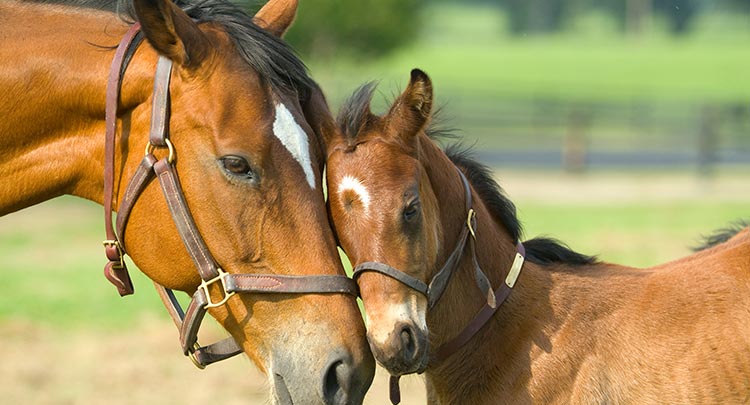Equine Breeding Services
Home » Equine Care » Equine Breeding Services
Equine Breeding Services at Salmon Brook Veterinary Hospital.
Salmon Brook Veterinary Hospital is proud to offer equine reproductive services! This service is offered by Dr. Rachel Prestigiacomo. If you would like to know more about these services please contact us.

Our services include:
Mare Breeding Soundness Exams
Many equine owners elect to perform a breeding soundness examination on their mare at the beginning of the breeding season. This is particularly important for older mares, mares with a previous history of infertility, or mares that have had a complicated pregnancy, delivery, or postpartum period. This examination will include a thorough physical exam, transrectal ultrasonographic exam, rectal palpation, and vaginal speculum exam. Uterine cytology, culture and biopsy specimens may also be obtained at this time.
Mare Tracking
Tracking a mare’s estrus cycle involves repeated ultrasonographic scans of the mare’s ovaries and uterus. This allows us to track follicular development, ovulation, corpus luteum formation, and uterine dynamics as a mare progresses through her natural cycle. The data derived from these scans informs breeding management, aftercare, and timing decisions.
Estrus Manipulation
Hormones (by oral or injectable routes) are commonly used to manipulate a mare’s estrus cycle. For clients interested in breeding, hormones can be used to synchronize a mare’s estrus cycle with another mare or according to stallion/semen availability, shorten the time between estrus periods, induce ovulation, or suppress estrus behavior altogether (which some owners elect to do during the show season to promote more predictable behavior). We can work with you to develop a protocol that fits your mare and schedule.
Artificial Insemination
Mares can be bred by a stallion (live cover) or by artificial insemination (AI). AI involves the introduction of fresh, fresh-chilled, or frozen semen directly into a mare’s uterus. Mares have the best chance of conceiving when inseminated with high-quality semen within hours of ovulation.
Post-Breeding Care
Following insemination, it is best practice to scan the mare again within a day or two to ensure that she has ovulated and there is no fluid remaining in the uterus, as retained uterine fluid may lower the chances of a successful pregnancy. We offer post-breeding ultrasonographic scans, uterine lavage, and continued medical treatment (anti-inflammatories and antibiotics as indicated) to help make the uterine environment as hospitable as possible for a pregnancy.
Pregnancy Diagnosis
A vesicle (the first sign of a potential pregnancy) can be seen via ultrasound as early as about 10 days following ovulation; however, the best time to perform an initial pregnancy check on a mare is about 14 days post-ovulation. A heartbeat check is traditionally performed around 25 days gestation to ensure fetal viability, and fetal sexing may be performed at 55-70 days gestation or around 110-120 days gestation. Pregnancy can be diagnosed at almost any stage in gestation via transabdominal or transrectal ultrasound examination.
Twin Management
Less than 10% of twin pregnancies result in two live foals born at term. Therefore, in the interest of the mare and the pregnancy overall we advocate early pregnancy diagnosis and twin reduction (when indicated) at about 14 days post-ovulation. This procedure is performed transrectally in a standing, sedated mare. There is some risk of total pregnancy loss when performed, but it is minimal when twins are detected early in gestation and much greater once the embryos have implanted at about day 16 and thereafter.
Caslick’s Placement and Removal
A Caslick’s procedure is indicated where a mare may have poor perineal conformation or previous foaling trauma that compromises the closure and seal of her vulvar lips. This may predispose her to infection, which may manifest as persistent vaginal discharge, ascending placentitis, or difficulty getting or keeping a mare in foal. The procedure involves the surgical closure of a portion of the vulvar lips to re-create what should naturally be an airtight and waterproof seal. If your mare has had a caslick’s, we will be glad to revere the procedure prior to her foaling, as foaling through a caslicks can cause severe trauma to the area.
We are also very pleased to offer neonatal and periparturient care. The following are a sample of some services:
Post-Foaling Examination
If a mare delivers uneventfully and the foal is able to stand, nurse, and pass meconium (the first feces), post-foaling exams are scheduled for approximately 16-20 hours post-delivery. At this exam, the dam will be examined to verify she has not suffered any injuries from foaling, that she is showing no signs of sepsis or blood loss and that she has no abnormalities involving her milk supply. Please save the placenta for us to examine to ensure that it is present in its entirety and there are no indications of disease. The foal will be examined for general health and congenital abnormalities, and a blood sample will be taken to ensure the foal has adequate passive transfer of antibodies from the dam’s colostrum.
Plasma Transfusion
Where indicated (in cases of insufficient passive transfer of antibodies) we can perform a plasma transfusion. Without adequate antibodies present in the blood, foals are at increased risk of sepsis (generalized infection) which may show up as pneumonia, swollen joints, an infected umbilicus, or other systemic disease.
Emergency Foaling Care
Though we hope never to experience foaling-related emergencies, we offer 24/7 large animal ambulatory coverage. We can provide verbal instructions for life-threatening situations like a red bag delivery where seconds count. We can make farm calls for clients within our practice area for other foaling-related emergencies such as dystocias (difficult deliveries), foals that cannot stand or nurse within 2 hours after birth, retained placentas (membranes that have not passed within 3 hours following delivery of the foal), abortions, or post-delivery colics in mares.

